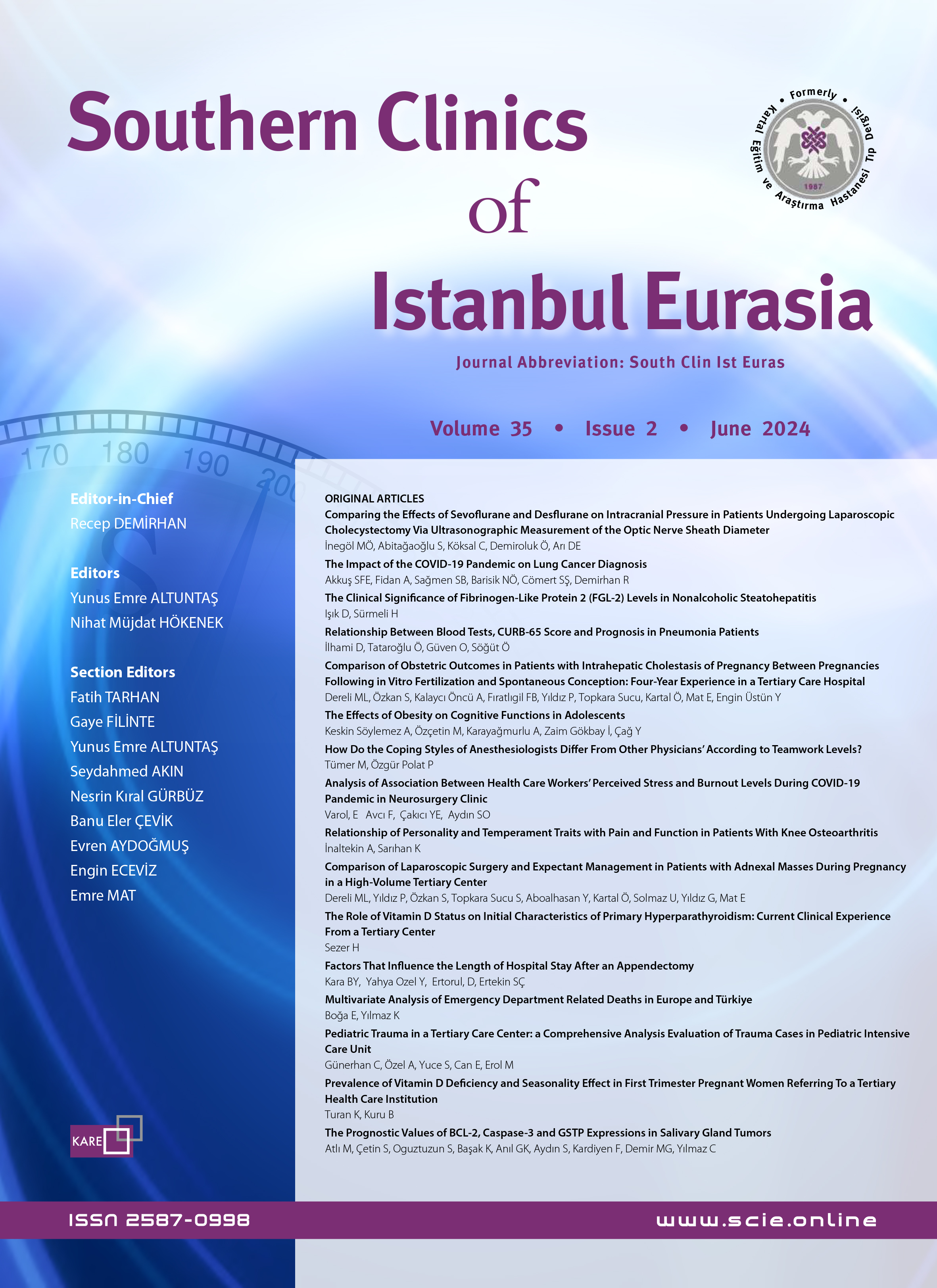Comparison of Fully Threaded Cannulated Screw, Half Threaded Cannulated Screw, and Tension-Band Wiring in the Fixation of Herscovici Type C Medial Malleolus Fractures: A Retrospective Clinical Study
Suat Batar1, Muhammed Enes Karataş3, Furkan Başak2, Mehmet Mete Oruç4, Bahattin Kemah2, Serdar Kamil Çepni21Department of Orthopaedics and Traumatology, Nev Anadolu Hospital, Bursa, Türkiye2Department of Orthopaedics and Traumatology, Umraniye Training and Research Hospital, Istanbul, Türkiye
3Department of Orthopaedics and Traumatology, Kartal Dr. Lütfi Kırdar City Hospital, Istanbul, Türkiye
4Department of Orthopaedics and Traumatology, Şırnak İdil State Hospital, Şırnak, Türkiye
Objective: Surgical treatment is often preferred for medial malleolus fractures to achieve anatomic reduction and enable early mobilization. This study aims to evaluate the clinical and radiological outcomes of fixing Herscovici Type C medial malleolus fractures using tension-band wiring (TBW) and half and fully threaded cannulated screws.
Methods: This retrospective study included patients aged 18 to 65 who underwent surgery for isolated medial malleolus fractures between January 2012 and December 2022. Exclusion criteria were a follow-up period of less than one year, fractures other than Herscovici Type C, open fractures, use of other implants, or loss to follow-up. Radiological evaluations were conducted using preoperative anterior-posterior, lateral, and mortise radiographs, along with computed tomography scans. The talocrural angle, corner angle, and alignment between the talus and tibial plafond were assessed. Clinical outcomes were measured using the American Orthopaedic Foot and Ankle Society (AOFAS) Ankle-Hindfoot Scale. Statistical analysis was performed using SPSS software.
Results: A total of 178 patients were included: 55 (30.9%) underwent TBW fixation, 60 (33.7%) had half-threaded cannulated screw fixation, and 63 (35.4%) received fully threaded cannulated screw fixation. The mean follow-up period was 76 months, and the mean age was 32.2 years. The TBW group had a significantly longer follow-up period than the other groups (p=0.000), with no difference between the half and fully threaded screw groups. There were no differences among the groups regarding fracture side, trauma mechanism, or need for implant removal. Postoperative talocrural angles were similar across groups (p=0.530). The postoperative corner angle was significantly lower in the TBW group (mean: 63.4) compared to the half-threaded (mean: 65.8) and fully threaded (mean: 65.2) screw groups (p=0.049). AOFAS scores were significantly higher in the half-threaded screw group (mean: 89.1) compared to the TBW (mean: 84.2) and fully threaded screw groups (mean: 85.9) (p=0.02). No significant difference was found between the half-threaded and fully threaded screw groups regarding the alignment between the superior facet of the talus and the anterior tibial plafond. The TBW group had a significantly higher number of patients with misaligned joints compared to the other groups (p=0.000).
Conclusion: Radiological outcomes were better in the half and fully threaded cannulated screw fixation groups compared to the TBW fixation group. The AOFAS scores were highest in the half-threaded screw fixation group. No significant differences were found among the groups regarding complications. The study concludes that cannulated screw fixation is a safer and more effective method for treating isolated medial malleolus fractures than the TBW fixation method.
Keywords: Cannulated screw fixation, medial mal-leolus fracture; tension-band wiring method.
Herscovici Tip C Medial Malleol Kırıklarında Tam Yivli Kanüle Vida, Yarım Yivli Kanüle Vida ve Gergi Bandı ile Tespitin Karşılaştırılması: Retrospektif Bir Klinik Çalışma
Suat Batar1, Muhammed Enes Karataş3, Furkan Başak2, Mehmet Mete Oruç4, Bahattin Kemah2, Serdar Kamil Çepni212
3
4
Amaç: Medial malleol kırıklarında anatomik redüksiyon sağlamak ve erken mobilizasyonu mümkün kılmak için genellikle cerrahi tedavi tercih edilir. Bu çalışma, Herscovici Tip C medial malleol kırıklarının tension-band wiring (TBW) ve yarım ve tam yivli kanüle vidalar kullanılarak tespit edilmesinin klinik ve radyolojik sonuçlarını değerlendirmeyi amaçlamaktadır.
Gereç ve Yöntem: Bu retrospektif çalışma, Ocak 2012 ile Aralık 2022 arasında izole medial malleol kırığı nedeniyle ameliyat edilen 18-65 yaş arası hastaları içermektedir. Bir yıldan az takip süresi olanlar, Herscovici Tip C dışındaki kırıkları olanlar, açık kırıkları olanlar, başka implant kullananlar veya takibi kaybedilenler çalışma dışı bırakıldı. Radyolojik değerlendirmeler, preoperatif anteroposterior, lateral ve mortis radyografileri ile bilgisayarlı tomografi taramaları kullanılarak yapıldı. Talokrural açı, köşe açısı ve talus ile tibia tavanı arasındaki hizalanma değerlendirildi. Klinik sonuçlar, Amerikan Ortopedik Ayak ve Ayak Bileği Derneği (AOFAS) Ayak Bileği-Arka Ayak Skalası kullanılarak ölçüldü. İstatistiksel analiz SPSS yazılımı kullanılarak yapıldı.
Bulgular: Toplam 178 hasta çalışmaya dahil edildi: 55i (%30.9) TBW tespiti, 60ı (%33.7) yarım yivli kanüle vida tespiti ve 63ü (%35.4) tam yivli kanüle vida tespiti uygulandı. Ortalama takip süresi 76 ay ve ortalama yaş 32.2 yıldı. TBW grubunun takip süresi diğer gruplara göre anlamlı derecede daha uzundu (p=0.000), yarım ve tam yivli vida grupları arasında fark yoktu. Kırık tarafı, travma mekanizması veya implant çıkarma ihtiyacı açısından gruplar arasında fark yoktu. Postoperatif talokrural açı gruplar arasında benzerdi (p=0.530). Postoperatif köşe açısı, TBW grubunda (ortalama: 63.4), yarım yivli (ortalama: 65.8) ve tam yivli (ortalama: 65,2) vida gruplarına göre anlamlı derecede daha düşüktü (p=0.049). AOFAS skorları, yarım yivli vida grubunda (ortalama: 89,1), TBW (ortalama: 84.2) ve tam yivli vida gruplarına (ortalama: 85.9) göre anlamlı derecede daha yüksekti (p=0.02). Talusun üst yüzeyi ile anterior tibia tavanı arasındaki hizalanma açısından yarım ve tam yivli vida grupları arasında anlamlı fark bulunmadı. TBW grubunda yanlış hizalanmış eklem sayısı diğer gruplara göre anlamlı derecede daha yüksekti (p=0.000).
Sonuç: Radyolojik sonuçlar, yarım ve tam yivli kanüle vida tespiti gruplarında TBW tespiti grubuna göre daha iyiydi. AOFAS skorları, yarım yivli vida tespiti grubunda en yüksekti. Komplikasyonlar açısından gruplar arasında anlamlı fark bulunmadı. Çalışmada, kanüle vida tespitinin izole medial malleol kırıklarının tedavisinde TBW tespiti yöntemine göre daha güvenli ve etkili bir yöntem olduğu sonucuna varıldı.
Anahtar Kelimeler: Gergi bandı yöntemi, kanüle vida ile tespit; medial malleol kırığı.
Manuscript Language: English




















